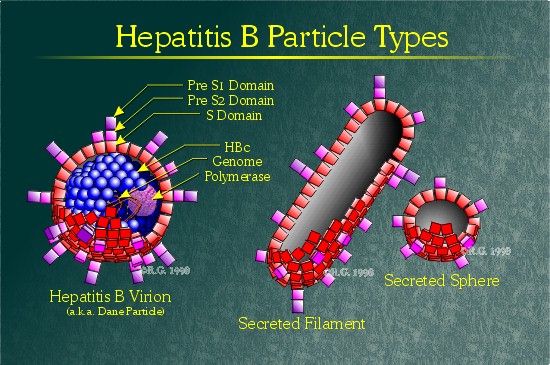
Hepatitis B Particle Types
Infectious and non-infectious particles can be found in high abundance within the serum of an acutely infected individual. The hepatitis B virion, also known as the Dane particle, has a diameter around 42nm. The outer envelope contains high amounts of hepatitis B surface proteins. The envelope surrounds the inner nucelocapsid which is comprised of 180 hepatitis B core proteins arranged in an icosahedral arrangement with T=3 and T=4 symmetry. (1), (2), (3) The nucleocapsid also contains at least one hepatitis B polymerase protein as well as the HBV genome. (4)
Two other subviral particles can be found in an infected individual's serum, namely the hepatitis B filament and hepatitis B sphere. Both particles have a diameter of 22nm and are composed solely of hepatitis B surface proteins. The absence of the hepatitis B core, polymerase, and genome reflects these particles' non-infectious nature. The sphere is composed of the small and middle hepatitis B surface proteins whereas the filament also includes the large hepatitis B surface protein.
High levels of these non-infectious particles can be found during the acute phase of infection. (5) Non-infectious particles present the same antigenic sites as the virion appear to be non-advantageous for the virus. High levels of these surface antigens induce a significant immune response from most who are infected. However, it is believed that the presence of such high levels of non-infectious particles may allow the infectious viral particles to traverse the blood stream undetected by neutralizing antibodies. (6) In addition, non-infectious particles have been reported to enhance HBV infection in the duck hepatitis B system. (7) Binding of non-infectious particles to potential host cells appears to activate the cells, possibly to prime the cells for infection. Whether this is also true for the human hepatitis B virus remains to be proven.

Purified virions possess the HBc protein which
aggregates to form the core particle. This, in turn, results in the encapsidation
of the viral genome and polymerase. In the mature virion, this core particle
ends up enveloped by the various hepatitis B surface
proteins. In addition,
there appears to be a protein kinase encapsidated within this core particle.
There appears to be a critical concentration of HBc required for particle assembly. Dimers of HBc protein are initially formed, assembling at 0.8uM concentration into isometric particles of T3 symmetry (180 HBc subunits form one core particle). The core particle appears made up of T-shaped dimers of the core protein which form outward spikes. The N-terminal of the two core proteins in the dimer are at the tip of the spike according to electron microscopic analysis. The assembled core particle is then stabilized through formation of disuphide bonds.
It has been more recently shown that the Pre-S1 and S domains of the envelope proteins interact with the core particle. This is not surprising as the core particle must become specifically packaged by membrane enriched for HBV surface proteins in order to generate the mature virion.
References:
1.
Crowther et al., 1994. Cell: 943
2. Nassal, H. and Schaller, H. 1993 in Virus Strategies, ed. W. Doerfler and P. Bohm, pp 42-74. VCH, Weinheim, Germany.
3. Onodera, S et al., 1982. J. Med. Virol.: 147.
4. Gerlich, W.H. and Robinson, W.S. 1980. Hepatitis B virus contains protein attached to 5' terminus of its complete DNA strand. Cell; 21: 801-809.
5. Hoofnagle, J.H., 1981. Serological markers of hepatitis B virus infection. Annu. Rev. Med.; 32:1-11.
6. Thomas, H.C. et al. 1988. Semin. Liver Dis.; 8: 342-
7. Burns, M., Miska, S., Chassot, S. and Will, H. Enhancement of Hepatitis B Virus Infection by Non-Infectious Subviral Particles. J. Virol; 72: 1462-1468.
